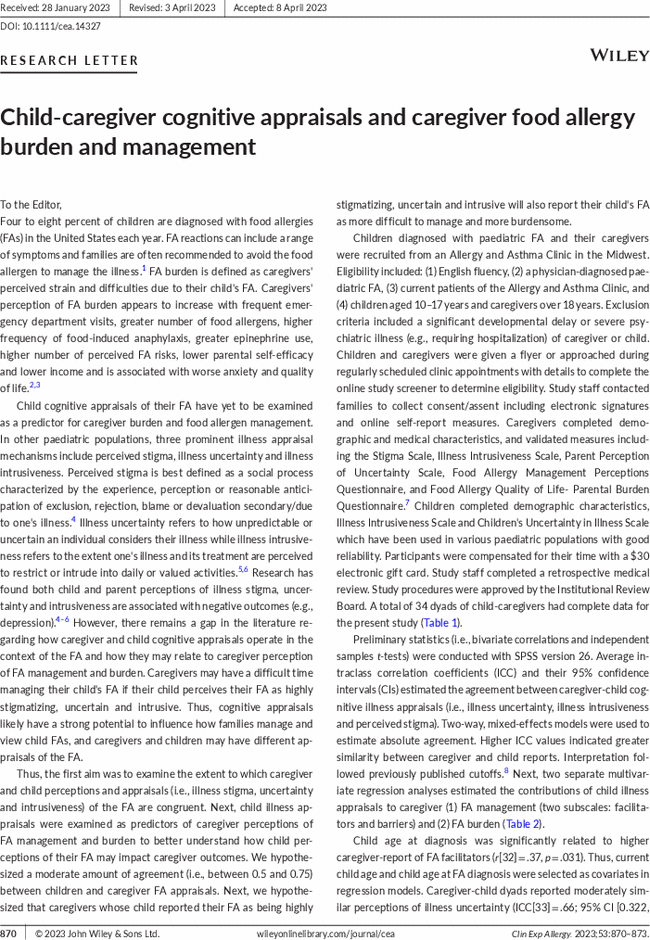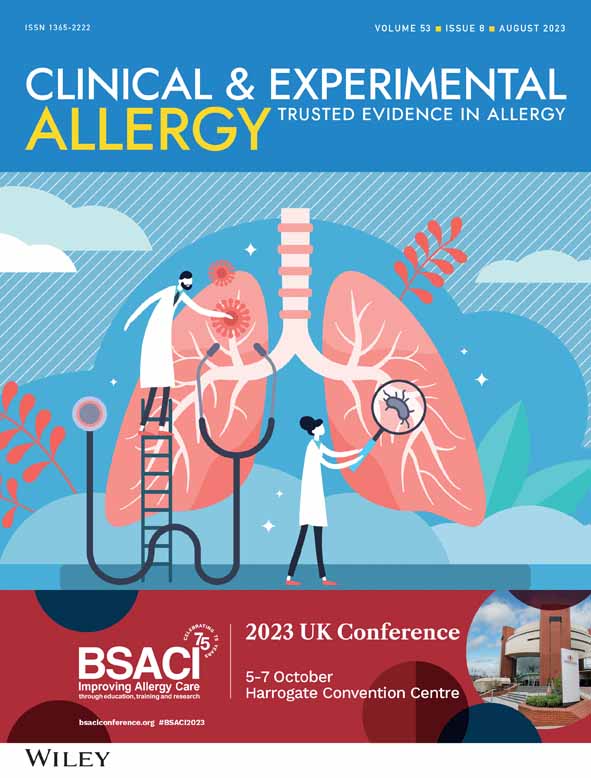Child-caregiver cognitive appraisals and caregiver food allergy burden and management
Corresponding Author
Taylor M. Dattilo
Department of Psychology, Center for Pediatric Psychology, Oklahoma State University, Stillwater, Oklahoma, USA
Correspondence
Taylor M. Dattilo, Department of Psychology, Center for Pediatric Psychology, Oklahoma State University, 116 Psychology Building, Stillwater, OK 74078, USA.
Email: [email protected]
Search for more papers by this authorCaroline M. Roberts
Department of Psychology, Center for Pediatric Psychology, Oklahoma State University, Stillwater, Oklahoma, USA
Search for more papers by this authorRachel S. Fisher
Department of Psychology, Center for Pediatric Psychology, Oklahoma State University, Stillwater, Oklahoma, USA
Search for more papers by this authorShahan Stutes
Oklahoma Allergy and Asthma Center, Oklahoma City, Oklahoma, USA
Search for more papers by this authorDean Atkinson
Oklahoma Allergy and Asthma Center, Oklahoma City, Oklahoma, USA
Search for more papers by this authorKaren Gregory
Oklahoma Allergy and Asthma Center, Oklahoma City, Oklahoma, USA
Search for more papers by this authorJ. Yamini V. Virkud
Department of Pediatrics, The University of North Carolina at Chapel Hill, Chapel Hill, North Carolina, USA
Search for more papers by this authorJessica MacDougall
Department of Pediatrics, The University of North Carolina at Chapel Hill, Chapel Hill, North Carolina, USA
Search for more papers by this authorCarrick Carter
Department of Pediatrics, University of Oklahoma Health Sciences Center, Oklahoma City, Oklahoma, USA
Search for more papers by this authorLarry L. Mullins
Department of Psychology, Center for Pediatric Psychology, Oklahoma State University, Stillwater, Oklahoma, USA
Search for more papers by this authorAlayna P. Tackett
Department of Internal Medicine, The Ohio State University Wexner Medical Center, Columbus, Ohio, USA
Search for more papers by this authorCorresponding Author
Taylor M. Dattilo
Department of Psychology, Center for Pediatric Psychology, Oklahoma State University, Stillwater, Oklahoma, USA
Correspondence
Taylor M. Dattilo, Department of Psychology, Center for Pediatric Psychology, Oklahoma State University, 116 Psychology Building, Stillwater, OK 74078, USA.
Email: [email protected]
Search for more papers by this authorCaroline M. Roberts
Department of Psychology, Center for Pediatric Psychology, Oklahoma State University, Stillwater, Oklahoma, USA
Search for more papers by this authorRachel S. Fisher
Department of Psychology, Center for Pediatric Psychology, Oklahoma State University, Stillwater, Oklahoma, USA
Search for more papers by this authorShahan Stutes
Oklahoma Allergy and Asthma Center, Oklahoma City, Oklahoma, USA
Search for more papers by this authorDean Atkinson
Oklahoma Allergy and Asthma Center, Oklahoma City, Oklahoma, USA
Search for more papers by this authorKaren Gregory
Oklahoma Allergy and Asthma Center, Oklahoma City, Oklahoma, USA
Search for more papers by this authorJ. Yamini V. Virkud
Department of Pediatrics, The University of North Carolina at Chapel Hill, Chapel Hill, North Carolina, USA
Search for more papers by this authorJessica MacDougall
Department of Pediatrics, The University of North Carolina at Chapel Hill, Chapel Hill, North Carolina, USA
Search for more papers by this authorCarrick Carter
Department of Pediatrics, University of Oklahoma Health Sciences Center, Oklahoma City, Oklahoma, USA
Search for more papers by this authorLarry L. Mullins
Department of Psychology, Center for Pediatric Psychology, Oklahoma State University, Stillwater, Oklahoma, USA
Search for more papers by this authorAlayna P. Tackett
Department of Internal Medicine, The Ohio State University Wexner Medical Center, Columbus, Ohio, USA
Search for more papers by this author
Open Research
DATA AVAILABILITY STATEMENT
The data that support the findings of this study are available from the corresponding author upon reasonable request.
REFERENCES
- 1Gupta RS, Springston EE, Warrier MR, et al. The prevalence, severity, and distribution of childhood food allergy in the United States. Pediatrics. 2011; 128(1): e9-e17.
- 2Knibb RC, Barnes C, Stalker C. Parental self-efficacy in managing food allergy and mental health predicts food allergy-related quality of life. Pediatr Allergy Immunol. 2016; 27(5): 459-464.
- 3Patel N, Herbert L, Green TD. The emotional, social, and financial burden of food allergies on children and their families. Allergy Asthma Proc. 2017; 38: 88-91.
- 4Scambler G. Health-related stigma. Sociol Health Illn. 2009; 31(3): 441-455.
- 5Pai AL, Mullins LL, Drotar D, Burant C, Wagner J, Chaney JM. Exploratory and confirmatory factor analysis of the child uncertainty in illness scale among children with chronic illness. J Pediatr Psychol. 2007; 32(3): 288-296.
- 6Devins GM. Using the illness intrusiveness ratings scale to understand health-related quality of life in chronic disease. J Psychosom Res. 2010; 68(6): 591-602. doi:10.1016/j.jpsychores.2009.05.006
- 7Warren C, Herbert L, Lombard L, et al. Validation of the parent-proxy reported food allergy-related quality of life questionnaire (FAQLQ-PF-10) short form in a large, multisite longitudinal cohort of food allergic child-parent dyads. J Allergy Clin Immunol. 2022; 149(2):AB123.
- 8Koo TK, Li MY. A guideline of selecting and reporting intraclass correlation coefficients for reliability research. J Chiropr Med. 2016; 15(2): 155-163. doi:10.1016/j.jcm.2016.02.012
- 9Mullins LL, Cushing CC, Suorsa KI, et al. Parent illness appraisals, parent adjustment, and parent-reported child quality of life in pediatric cancer. Pediatr Hematol Oncol. 2016; 33(5): 314-326. doi:10.1080/08880018.2016.1198443




